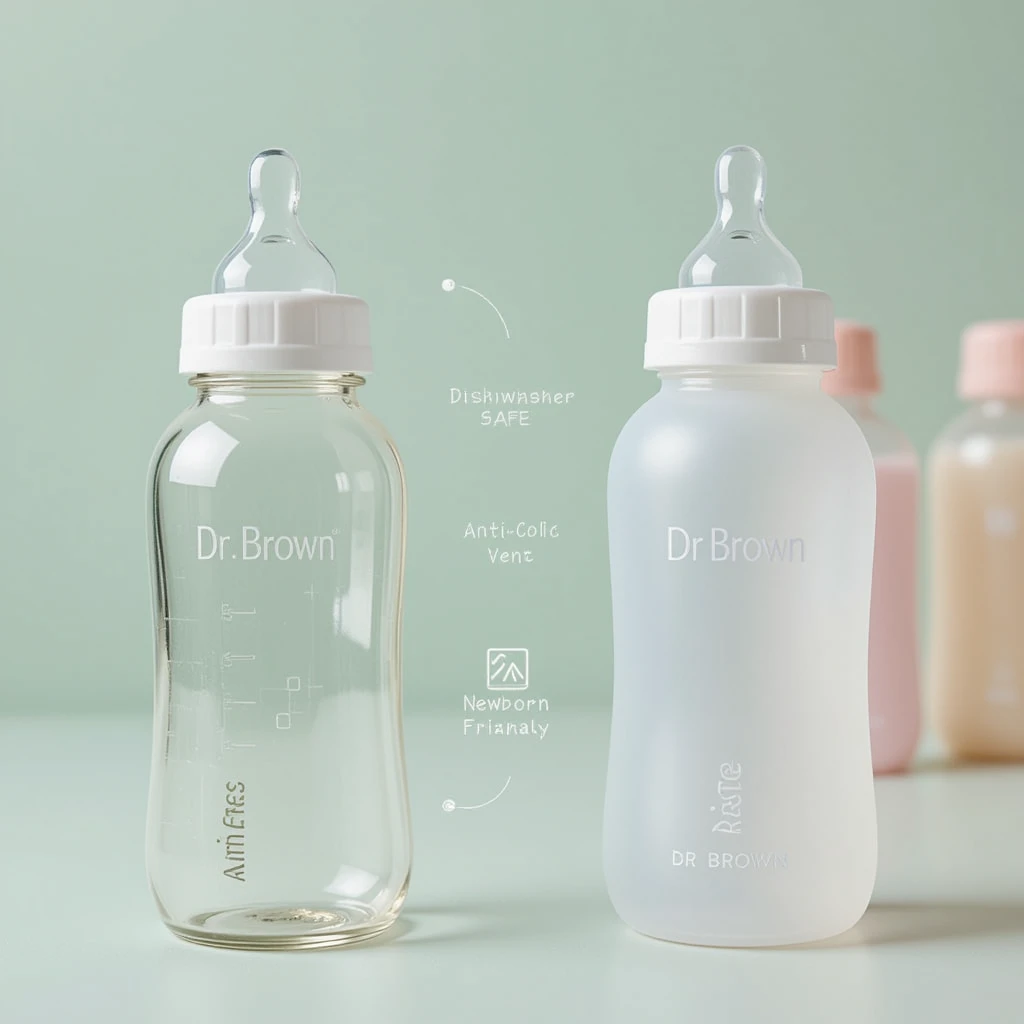Glass vs. Plastic: Which Dr. Brown Bottle Is Right for You?
Introduction
Choosing the right bottle for your baby can feel confusing. There are many options out there, and it’s easy to get lost. One of the most trusted brands is Dr. Brown bottles, but even within this brand, you’ll need to decide between two popular types: glass Dr. Brown bottles and plastic Dr. Brown bottles.
So how do you choose? This article will help you understand everything you need to know about Dr. Brown bottles, from how they work, to how they clean, to what to watch out for. We’ll also cover common concerns like leaks, dishwasher safety, and even the rare case of a Dr. Brown bottles recall.
Let’s walk through it step by step — clearly, simply, and in plain words.
What Makes Dr. Brown Bottles Different?
Dr. Brown bottles are best known for their special vent system. This system helps babies drink milk or formula without swallowing a lot of air. Less air means less gas, fewer tummy troubles, and a happier baby. That’s why many parents choose them right from the start, especially when looking for Dr. Brown bottles for newborns.
You can find Dr. Brown bottles made from two main materials: glass and plastic. Both types use the same vent system, and both are trusted by parents and doctors.
What’s the Difference Between Glass and Plastic Bottles?
Here’s a simple breakdown of how glass Dr. Brown bottles and plastic Dr. Brown bottles compare:
| Feature | Glass Dr. Brown Bottles | Plastic Dr. Brown Bottles |
|---|---|---|
| Weight | Heavier | Lighter |
| Durability | Can break if dropped | Tough and hard to break |
| Dishwasher Safe? | Yes | Yes |
| Lifespan | Very long-lasting | May wear down over time |
| Eco-Friendliness | More environmentally friendly | Less eco-friendly |
| Cost | Usually more expensive | Usually less expensive |
| Baby Preference | Feels more like glass or real bottle | Feels lighter and easier to hold |
Some parents prefer glass Dr. Brown bottles because they feel cleaner and more natural. Others like plastic Dr. Brown bottles because they don’t break and are easier to carry. Both are safe. It just depends on your needs and comfort.
Are Dr. Brown Bottles Safe?
Yes, both glass and plastic Dr. Brown bottles are very safe. They do not contain BPA, which is a harmful chemical that used to be in some plastics. All modern Dr. Brown bottles meet safety rules and pass strict tests.
Some people have heard about a Dr. Brown bottles lawsuit or worry there may have been a Dr. Brown bottles recall. These concerns are understandable, but here’s the truth:
-
There has not been a serious Dr. Brown bottles lawsuit linked to bottle safety.
-
There was once a recall many years ago, but it involved a bottle warmer cord, not the bottles themselves.
So you can trust that Dr. Brown bottles are safe for your baby to use.
What About Leaks?
One of the most common questions from parents is: “Do Dr. Brown bottles leak?”
They can leak sometimes, but it usually happens because something was done wrong. These bottles use a special vent system. If you don’t put the parts together correctly, or if you shake the bottle with the vent in place, it might leak.
Here are a few tips to help avoid leaks:
-
Make sure all parts are clean and dry before use.
-
Assemble the bottle carefully. Follow the steps in the instructions.
-
Do not overfill the bottle.
-
Don’t shake the bottle with the vent inside. Shake it with the cap on, then put in the vent.
If you do these things, you’ll likely never deal with leaks.
Can I Wash Dr. Brown Bottles in the Dishwasher?
Yes! Both glass Dr. Brown bottles and plastic Dr. Brown bottles are dishwasher safe. That’s a big help when you’re washing bottles every day.
Just be sure to put all the small parts (like the vent and nipple) into a little basket or container. That keeps them from getting lost or damaged in the dishwasher. You can also use a bottle brush to clean them by hand if you prefer.
Are They Good for Newborns?
Absolutely. In fact, many parents choose Dr. Brown bottles for newborns because of the vent system. Newborns have tiny stomachs and often swallow air when drinking. That leads to gas, burping, and sometimes crying.
The vent system inside Dr. Brown bottles helps reduce air bubbles in the milk. This helps your baby feel more comfortable and drink more easily. Many hospitals and pediatricians recommend these bottles for newborns for this exact reason.
Do They Come in Fun Colors?
Yes! Dr. Brown bottles don’t just come in clear or plain white. You can also find pink Dr. Brown bottles, blue ones, green ones, and even bottles with cute patterns. The color doesn’t change how the bottle works, but it can make feeding time more fun.
Some babies even seem to like certain colors more. So if pink is your baby’s favorite, pink Dr. Brown bottles might make bottle time easier.
So, Which One Should You Choose?
The truth is, there’s no one-size-fits-all answer. But here’s how to think about it:
-
Choose glass Dr. Brown bottles if you want something long-lasting, strong, and more natural feeling. They’re a bit heavier and can break, but many parents love how clean they feel.
-
Choose plastic Dr. Brown bottles if you want something light, easy to carry, and harder to break. These are great for travel and are often less expensive.
Whichever you pick, you’ll get the same vent system, the same nipple options, and the same trusted quality that parents have relied on for years.
Final Thoughts
When it comes to feeding your baby, comfort, safety, and ease matter most. Dr. Brown bottles give you all three. Whether you pick glass Dr. Brown bottles or plastic Dr. Brown bottles, you’ll get a bottle that helps reduce gas, keeps feeding calm, and grows with your baby.
Just make sure to follow the instructions to avoid leaks, clean all the parts well, and choose the nipple size that fits your baby’s age. If you want color, go for it — pink Dr. Brown bottles and other colors are just as good as the clear ones.
In the end, the best bottle is the one that works for your baby — and feels right in your hand.

